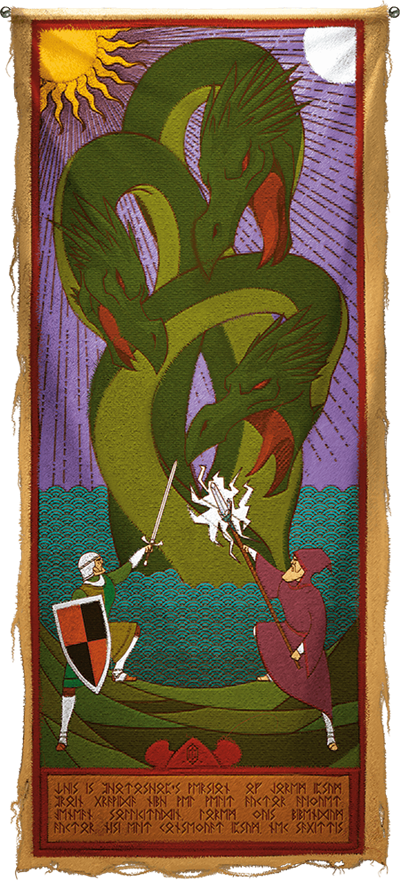 We’ve completed our second full rotation of the twelve classes in the Player’s Handbook, not to mention taken a deep dive into the first 5 levels of D&D’s thirteenth class, the inventive and arcane Artificer! This wave of the Class 101 series will appraise every subclass within the Player’s Handbook and break down each subclass’s strengths, weaknesses, thematic elements, and everything else a player would want to know before playing that subclass. Because of this, you will need to own the Player’s Handbook (or purchase the subclass a la carte on the Marketplace) in order to make full use of this series.
We’ve completed our second full rotation of the twelve classes in the Player’s Handbook, not to mention taken a deep dive into the first 5 levels of D&D’s thirteenth class, the inventive and arcane Artificer! This wave of the Class 101 series will appraise every subclass within the Player’s Handbook and break down each subclass’s strengths, weaknesses, thematic elements, and everything else a player would want to know before playing that subclass. Because of this, you will need to own the Player’s Handbook (or purchase the subclass a la carte on the Marketplace) in order to make full use of this series.
The fighter class is one of the most thematically versatile classes in Dungeons and Dragons. That is to say, while classes like paladin or warlock impose a certain level of roleplaying flavor on your character from the very beginning, a fighter is more or less a blank canvas for your own character’s story. When playing an Eldritch Knight, a type of fighter that uses weapons and destructive spells in conjunction, you’re free to determine how you gained your martial and magical skills, and what you want to achieve with them.
Check out the other guides in the Class 101 series, like the broad overview of the druid class in Fighter 101: A Beginner’s Guide to Heroic Combat, Fighter 101: Champion, and Fighter 101: Battle Master. If you’re interested in playing other classes, check out the entire Class 101 series.
Story of the Eldritch Knight
“What are you doing?” a young brother asked his sister. The sister, a fighter, knelt before a makeshift altar cobbled together by wooden boards atop two sawhorses, draped with a simple burlap cloth. A longsword rested on the altar. Her eyes were closed, and she was dressed in a simple tunic and breeches, her hair pulled into a bun. The suit of armor she had inherited from her father hung on a stand nearby. Her brow twitched with annoyance as her brother spoke.
“I’m meditating,” she grumbled. She let out a long breath and reached out into the aether once more with her consciousness, feeling for the strands of the Weave that were strung invisibly around her. She hovered her open hand over the hilt of sword, and felt new strands of magic forming between the wellspring of magic within her and the sword.
“Can I help?” her brother, bounding to her side, a huge grin on his face. “You meditating with that sword? You gonna do magic? Can I see? Can I see your magic?”
The sister scowled and growled through gritted teeth, “If you can sit still for ten minutes, yes.”
Miraculously, he was. He sat cross-legged next to his kneeling sister, alternating between gawking at the look of calm concentration on her face and the gently humming sword on the homemade dais before her. Ten tense minutes passed, and the fighter’s eyes snapped open. A flash of light glinted upon her irises, and then vanished just as quickly as it appeared. She stood and flexed her trembling hand.
“Okay,” she said to her brother, pointing to the sword. “Take it.”
“Really?” her brother gasped, eyes wide and shining with excitement.
“Yeah, really,” the fighter said, looking away. “Just watch the blade and don’t hurt yourself. Or, if you do hurt yourself, say you were playing in the forest. Mom’ll kill me otherwise.”
“Whoo hoo!” her brother whooped. He picked up the sword and swung it into the air over his head. He ran around the cellar room, slashing at invisible foes and imagining he was just like their father, killing monsters that threatened their village. His sister smiled at his excitement, then focused herself. She focused her eyes upon the hilt of the sword as her brother ran about and steadied her breathing. She tuned out all the distractions of the Material Plane and focused solely upon the strands of the Weave that bound her to the blade. She felt a surge of energy tingle from her chest down her arm, and at the moment the surge passed through her fingertips, the sword vanished from her brother’s hands.
Her brother yelped and looked around. “Ahhh! It’s gone!” he gasped. “I’m so sorry, it just—!” He turned to his sister and his jaw dropped open. Clutched in his sister’s right hand was her father’s sword. Her heart was pounding as she stared at the sword she had just magically conjured to her, but she managed to compose herself and look at her brother with a flicker of smugness.
“See?” she said. “Magic.”
Eldritch Knight Features
Eldritch Knight fighters memorize a number of destructive and protective spells during their training, in addition to other magical abilities that allow them to meld their martial and magical prowess. The fighter gains access to five subclass features at 3rd, 7th, 10th, 15th, and 18th level. You can read all of the Eldritch Knight features in the Player’s Handbook. In summary, your subclass features allow you to:
- You learn two cantrips from the wizard spell list
- You gain the ability to memorize and cast a number of abjuration and evocation spells from the wizard spell list
- You bond with your weapon, allowing you to summon it to your hand at any time
- You can make a weapon attack as a bonus action when you cast a cantrip
- Your weapon attacks make creatures less likely to succeed on saving throws against your spells
- You can teleport short distances when you use your Action Surge feature
- You can make a weapon attack as a bonus action when you cast a spell as an action
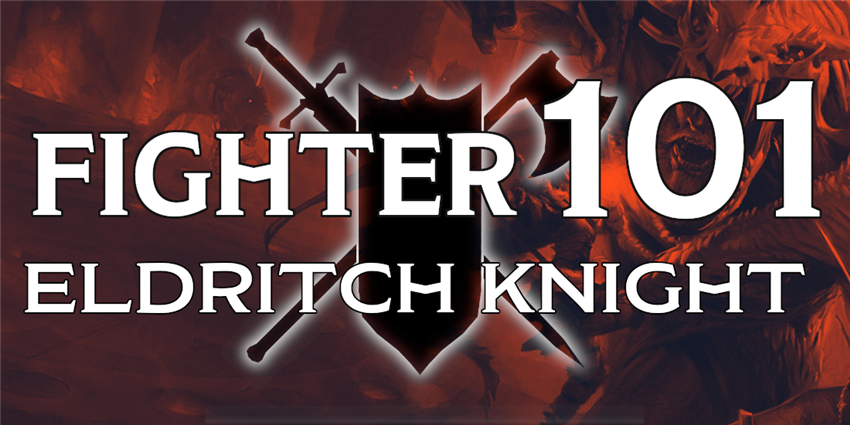
Benefits of the Eldritch Knight
There are a number of different options available for people who want to wield both spells and weapons—what does the Eldritch Knight bring to the table? The paladin offers a “jack of all trades” option by combining heavy armor and spiky damage through Divine Smite, the bardic College of Valor and clerical Light Domain provide spell-heavy options for moderately armored warriors, and the Bladesinger wizard tradition encourage lightly armored warriors to dance into battle, supported by their mighty spells.
Eldritch Knights curve in the opposite direction, using spells to complement their impressive suite of powerful defenses and overwhelming attacks. Typically, fighters can only focus on single targets with their attacks, and struggle against foes whose armor shrugs off these attacks. This encourages a very specific playstyle for Eldritch Knights: focus on spells that target multiple foes (or that effect an area), and find spells that force enemies to make a saving throw instead of requiring you to make an attack roll.
Your spells are situational tools, and the limited number of spell slots you get per day are a stark reminder of this. Don’t forget: you’re still a fighter first. Stay in the thick of combat, bashing helmets and tanking blows until your enemies have all clumped up around you, then let loose a well-timed burning hands to maximum effect. If you want to add a little more variety to your repertoire than evocation (offensive) or abjuration (defensive) spells can offer, you can add a spell from any school of magic to your list of Spells Known at 8th, 14th, and 20th level.
As you gain levels in this class, your class features will help make you more flexible. Generally, you’ll have to choose between making an attack and casting a spell on a given turn. Features like War Magic, Eldritch Strike, and Improved War Magic make this choice much less painful by letting you cast spells and make an attack in the same turn—and even giving you a benefit to doing so against the same foe.
Drawbacks of the Eldritch Knight
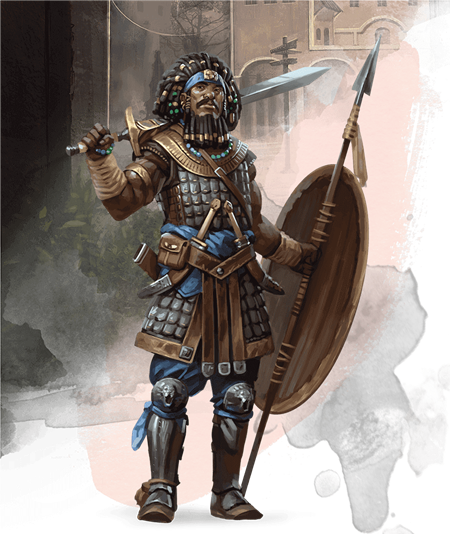 The biggest challenge of playing an Eldritch Knight is a conflict between casting spells and making attacks. These two styles of D&D combat mix like water and oil, and it’s difficult to meld them together in a way that evokes the fluid feelings of magically enhanced martial combat in popular fantasy series like Avatar: The Last Airbender or Star Wars. Casting a spell and making a weapon attack are two discrete actions; unless you’re using a purpose-made cantrip like green-flame blade, you can’t weave magic into a sword strike.
The biggest challenge of playing an Eldritch Knight is a conflict between casting spells and making attacks. These two styles of D&D combat mix like water and oil, and it’s difficult to meld them together in a way that evokes the fluid feelings of magically enhanced martial combat in popular fantasy series like Avatar: The Last Airbender or Star Wars. Casting a spell and making a weapon attack are two discrete actions; unless you’re using a purpose-made cantrip like green-flame blade, you can’t weave magic into a sword strike.
Spells that can be cast as a reaction or a bonus action, like misty step or shield, soften this issue somewhat, allowing you to make an attack and then repel your foes’ strikes with a shimmering barrier of force. Nevertheless, it can be frustrating to have to page through a list of abjuration or evocation spells with a casting time of 1 reaction or 1 bonus action to find what spells will support the character concept you have in your head.
At least that sort of research digitally is much easier than doing so with a print book, thanks to the D&D Beyond Spell tool—which, troublingly, reveal the limits of this restriction: there are only three 1-reaction-casting-time spells that fit those criteria, and no 1-bonus-action-casting-time spells. So, while the Eldritch Knight is a reasonably powerful class, the challenges of melding spellcasting and sword fighting into one fluid motion may frustrate you if you’re looking for a highly cinematic experience in your D&D game.
If you want to be able to cast spells and fight, but you’re playing a low-level one-shot or don’t think your campaign will advance past 6th level, you might be better off playing a Champion fighter and taking Magic Initiate (Wizard) feat, granting you two wizard cantrips and one 1st-level wizard spell that you can once per long rest. Your spellcasting will be much more limited than if you’d chosen to play an Eldritch Knight—at 5th level, an Eldritch Knight knows two cantrips but also knows 4 wizard spells and has three 1st-level spell slots with which to cast them. However, if giving your fighter a little bit of magical flavor is all you want, then Champion’s suite of simple, powerful combat-focused features might be more appealing.
Suggested Build
Like most classes in D&D, the fighter doesn’t choose their subclass until 3rd level. If you’re playing a fighter from 1st level and think you want to become an Eldritch Knight later, you should choose a race that improves your Strength (or Dexterity) score and also your Intelligence score. Strength affects how hard you hit with most melee weapons, whereas Dexterity makes you better with ranged or finesse weapons. Your Intelligence score affects how likely you are to hit with your spell attacks, and how high your spell save DC is, which makes it harder for foes to resist your spells. Because of this, your Strength or Dexterity score should be your highest ability score, and your Intelligence should be your second highest score.
You can play an Eldritch Knight as a heavily armored, greatsword-wielding tank, or as a lithe and nimble, rapier-wielding duelist. If you want to play the former, some good races include half-orc, dragonborn, rock gnome, and mountain dwarf. To play the latter, races like forest gnome and high elf will do the trick. Humans and half-elves are well-suited to just about any class, as well.
As usual, your character’s background is up to you. You can come up with all sorts of interesting stories and oddball characters by pairing unlikely backgrounds with the Eldritch Knight’s particular blend of sagely study and rough-edged athleticism. Were you a Sage who abandoned a rigorous regimen of “useless” magical study to practice destructive arts instead? Or were you a Noble whose tutors encouraged you to dabble in many different forms of martial artistry?
It’s a safe bet to choose EQUIPMENT when given the choice between GOLD or EQUIPMENT during character creation. The various types of equipment available to fighters easily suits either a Strength or Dexterity-focused playstyle. Choose chain mail and a martial weapon plus a shield if you want to focus on Strength, and choose leather armor, a longbow, and a rapier if you want to focus on Dexterity. Since you will gain class features that allow you to make weapon attacks as a bonus action when you cast a spell, you should focus on wielding a shield and a rapier if you want to be a Dexterity-based fighter, rather than dual wielding light weapons.
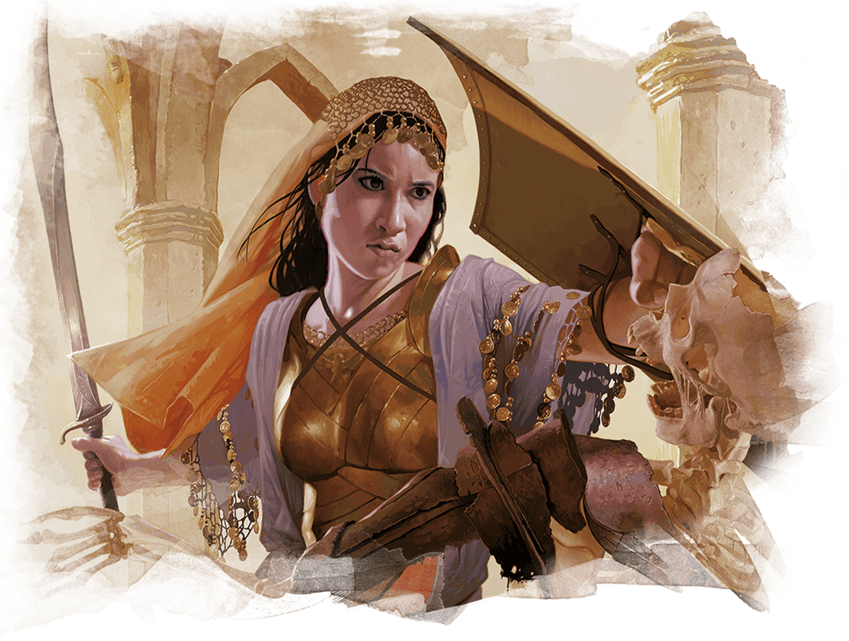
Spells
You gain the ability to cast spells when you choose this subclass at 3rd level. Your spell selection is quite limited—not only do you memorize spells instead of being able to prepare them at the start of a day, but you only have a scant two 1st-level spell slots to use. While this number increases as you level up, it encourages you to reserve your spells for big, flashy moments of destruction, or in desperate last-ditch efforts.
As a 3rd-level Eldritch Knight fighter, you know two cantrips from the wizard spell list. Since you’re likely to be in melee combat, it’s good to choose one offensive cantrip with a range of at least 60 feet to extend your reach. Your second cantrip should be either a utility cantrip to help round out your character’s skill set, or an offensive cantrip with a range of 5 feet, so that you don’t have to worry about having disadvantage when making a ranged attack while in close combat.
Also at 3rd-level, you know three spells: two 1st-level abjuration or evocation spells from the wizard spell list, and one 1st-level spell of any school from the wizard spell list. Choose these spells wisely; though you can trade out one spell you know for another when you gain a level in this class, these spells are otherwise permanent decisions. It’s wise to know at least one spell labeled OFFENSE and one labeled DEFENSE, and choose your third spell based on what you think your character would want to know. Note that this list only includes some spells from the Player's Handbook, so if you want to choose more unusual spells, or have other sources like Xanathar's Guide to Everything, you'll have to do a little self-directed research. This list is just here to get you started if this is your first time playing an Eldritch Knight.
- Alarm (SUPPORT)
- Burning hands (OFFENSE)
- Chromatic orb (OFFENSE) [be aware that you’ll have to purchase a diamond worth 50 gp in order to cast this powerful spell!]
- Magic missile (OFFENSE)
- Protection from evil and good (DEFENSE)
- Shield (DEFENSE)
- Thunderwave (OFFENSE)
Feats
As a fighter, you gain two more Ability Score Increases than any other class in the game. (The extras come at 6th and 14th level.) This means that it’s incredibly easy for you to take one or even two feats while still maxing out your vital ability scores!
Once you’ve improved your Strength or Dexterity score to 18 or 20, you can increase your power with a few useful feats. The following feats are good picks for Eldritch Knight fighters, and will improve your reliability in your own desired area of expertise:
Great Weapon Master. These days, it practically goes without saying that Great Weapon Master is one of the best feats in the game. Choosing this feat will send your damage output into the stratosphere, though only if you’re using a two-handed weapon.
Polearm Master. This feat synergizes well with War Caster and Sentinel, making it difficult for enemies to approach you or maneuver around you.
Sentinel. A must-have feat for any fighter interested in tanking for their party, Sentinel makes it hard for enemies to attack your allies, or for them to leave your reach once they’ve approached you.
Shield Master. A specialized but useful choice for Eldritch Knights who want to wield a shield rather than go for a two-handed weapon. An excellent choice for Dexterity-focused fighters wielding a rapier and a shield.
War Caster. Eldritch Knights, especially those who wield a one-handed weapon and a shield, can make use of every aspect of this feat. Making it easier to maintain concentration while taking damage is always a benefit, and not having to have a hand free to perform a spell’s somatic components is a huge boon when you can't afford to drop your shield or your rapier. Gaining the ability to make opportunity attacks with your spells is also excellent! Just imagine hurling a guaranteed-to-hit magic missile at a fleeing foe.
If you want more advice for building a fighter, check out Fighter 101. Have you ever played an Eldritch Knight fighter? What advice would you give to players that want to play this subclass? Next week, Class 101 will cover the monk's Way of Shadows archetype, an unseen ascetic who strikes from the shadows. What's your fighter character like? Let us know in the comments!
Create A Brand-New Adventurer Acquire New Powers and Adventures Browse All Your D&D Content
 James Haeck is the lead writer for D&D Beyond, the co-author of Waterdeep: Dragon Heist, Baldur's Gate: Descent into Avernus, and the Critical Role Explorer's Guide to Wildemount, a member of the Guild Adepts, and a freelance writer for Wizards of the Coast, the D&D Adventurers League, and other RPG companies. He lives in Seattle, Washington with his fiancée Hannah and their animal companions Mei and Marzipan. You can find him wasting time on Twitter at @jamesjhaeck.
James Haeck is the lead writer for D&D Beyond, the co-author of Waterdeep: Dragon Heist, Baldur's Gate: Descent into Avernus, and the Critical Role Explorer's Guide to Wildemount, a member of the Guild Adepts, and a freelance writer for Wizards of the Coast, the D&D Adventurers League, and other RPG companies. He lives in Seattle, Washington with his fiancée Hannah and their animal companions Mei and Marzipan. You can find him wasting time on Twitter at @jamesjhaeck.








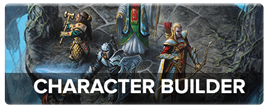
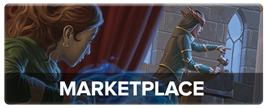
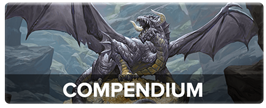
-
View User Profile
-
Send Message
Posted Oct 3, 2020And there's the key flaw. The only time thrown weapons are viable compared to Fire Bolt is when you are losing multiple attacks per Attack action, because you cast Fire Bolt instead, or at 5-6, when you can't attack a bonus action. At that point, the character is well past "starting equipment".
I do agree though, as a starting EK, 1 melee & 1 thrown is the way to go, unless you can get your GM to agree that shields are weapons. If they disagree, just hit them over the head with a garbage can lid / light shield or a hubcap / buckler until then concede. And really, given Improvised Weapons, isn't everything *cough* beer stein *cough* a weapon?
-
View User Profile
-
Send Message
Posted Oct 3, 2020It's not a flaw, and I think you're being reductionist to say so. You can't always assume what players will and won't have for their characters. When I played an EK last year, I was in my starting chainmail until level 7. I didn't even get a magic weapon (I eventually took the spell for that), but I did silver a greatsword.
And when I did have magic weapon, I was still reliably using a handaxe and shield. Because I'd rather swing twice with +7 to hit for 7.5 (15 total) slashing each time, with the option to throw my axe and recall it like Mjolnir, than shoot once with +6 to hit for 11 fire. (Not that I took fire bolt. My cantrips were booming blade and control flames on account of my lantern of revealing.)
-
View User Profile
-
Send Message
Posted Oct 3, 2020Except that it's not 2 swings & a recall vs just Fire Bolt, as you can also swing as a bonus action after casting a cantrip at level 7 (instead of recalling as your BA). And then there's swapping the hand axe for a battle axe. So you get 2 free damage if you swing twice, and can go two-handed for another damage boost if you lose the shield for whatever reason, unless you chose the dueling fighting style. And, IMO, it fits the Mjolnir theme better. Who sees Thor throwing it and thinks "Yup, that's a light hammer, not a war hammer."? I'm willing to say no one. Just let your GM know that lightning covered boomerang axes are your jam, and work something out. You're doing longbow damage, and spending a BA that a archer wouldn't be. Instead of a magic quiver of endless arrows, you get a magic axe. More or less the same mechanical effects, different roleplaying flavor.
-
View User Profile
-
Send Message
Posted Oct 4, 2020I can't believe I actually have to type this out, but not everything should come down to raw damage potential. Still, even if you compare the numbers the handaxe comes out ahead. Strictly, on an action-to-action basis, two swings of the handaxe grant a chance of dealing more damage. It also has more points of failure, but you're more likely to inflict at least some damage than none. And casting a ranged spell attack while in melee with a threatening enemy has its own problems. A cantrip like acid splash might be a more optimal choice than, say, fire bolt.
And any attack made with the Bonus Action shouldn't factor into DPR calculations. Sure, you can cast a cantrip and attack with War Magic, but you won't always. Remember, we're talking about playing a Fighter. Second Wind is something to do if you're short on hit points. Perhaps you want to cast a spell which requires your Bonus Action, like misty step. If you're fighting with two weapons, then attacking with two handaxes and making the off-hand attack will really bring the pain. If you're fighting with an axe and shield, then the first benefit of the Shield Master feat might be preferable. (It can even interrupt your normal Attack action, possibly granting advantage on any followup melee attacks within 5 feet.) Or maybe you're playing a goblin and want to make use of Nimble Escape. I could go on, but you get the idea.
Use a bigger weapon, if you want, or don't. It doesn't matter to me. A battleaxe has the potential for even more damage, but then you're not throwing it. Or, if you do, then it's an Improvised Weapon and you're probably not throwing with your Proficiency Bonus. The point of the original comment you replied to, the point I'm defending, is about giving players more options. Why you seem so dead set against that I have no idea.
EDIT
(And Mjolnir is a legendary light hammer because it's always one-handed. That's part of its mythology.)
-
View User Profile
-
Send Message
Posted Oct 4, 2020Mjolnir was always one-handed because Thor was strong enough to wield it one-handed due to being the mightiest of the Asgardians. None of the other gods weere capable of lifting it at all.
-
View User Profile
-
Send Message
Posted Oct 4, 2020Mjolnir was one-handed because the handle was too short to be used in two. That's because Loki decided to play a prank and turn into a fly to mess with the dwarves making it, causing them to screw up and give it the short handle. Yes, Thor was strong. He also had a magic belt to double his strength and needed special gloves to even wield it because of its power.
Which, among its ability to manipulate weather, could also heal and even resurrect the dead.
-
View User Profile
-
Send Message
Posted Oct 6, 2020This class would be 10x more satisfying if it got the weapon related smite/strike spells and ranger and paladin. (ensnaring strike, hail of thorns, lighting arrow, searing smite, thunderous smite, wrathful smite, branding smite, blinding smite, staggering smite, and maybe several more unique ones).
The old arcane gish classes from prior editions such as the swordmage and duskblade were THE masters of blending combat and magic, and now this has been explicitly removed from them and given to paladins and rangers instead. So now the very class which was built around that kind of play is the one excluded from that type of play, making the entire thing just feel hollow and unsatisfying to use. You're better off just fighting like a normal fighter and then spamming shield when needed.
I really don't understand the reasoning behind specifically taking this feature away from the arcane gish and giving it to other classes instead. I'd have understood giving it to those classes to share, but specifically taking it from the arcane gish feels almost mocking.
I'm honestly exited for my main campaign lvl 7 EK to die so I can play something actually enjoyable.
-
View User Profile
-
Send Message
Posted Oct 6, 2020None of those spells are available to the Eldritch Knight, on account of the archetype's roots. Others, like the swordmage and duskblade, simply do not exist yet. And they might never exist; only time will tell. But you can play an "arcane gish" if you want. Bards have two colleges (Swords and Valor), warlocks have the Pact of the Blade, and wizards have Bladesinger. Other classes, like the paladin and ranger, are divine gishes. And they all play differently. This isn't a bad thing.
Sorry to hear you aren't having fun. Maybe you should talk with your DM about your expectations and try to figure out a way there; up to and including rebuilding your character. That said, it's important to remember that you chose to play a fighter. And your character will always be a fighter first, and an eldritch knight second.
-
View User Profile
-
Send Message
Posted Oct 6, 2020I mean that's the limitation with the subclass system 5e has gone for. The class will always be class first, and subclass second. Combined with the refusal to add more full classes, and there are certain archtypes which 5e fails in compared to prior editions. Every other arcane gish you just mentioned has the same issues which is lack of spellstrike (some have like one spell in their list which can), which paladin does have this edition. And every time I want to play something like that everyone just tells me to play EK.
It's like asking for a class which has rage as a feature and everyone directing you to fighter.
EK is very clearly designed as an imitation of the 4e swordmage though, as its subclass features are near identical.
-
View User Profile
-
Send Message
Posted Oct 6, 2020Maybe it's just me, but I'm not seeing how any of this is a problem. Subclasses, by definition, supplement rather than define. They're the pretty shell of the car, rather than the chassis and engine under the hood. And while an abundance of subclasses still comes with its own form of bloat, it also helps cut down on page count for new books. Which means we can have more of other content. And spellstrike was never the defining trait of the gish archetype, even if some classes had it. The eldritch knight lifts as much from the old prestige class of the same name (and the assumption of a fighter/wizard split) as it does from the swordmage and when "elf" was its own class 40+ years ago.
Nothing ever gets a 1:1 translation from edition to edition. Now, you're more than welcome to go looking at DM's Guild or homebrew up something closer to what you want. There's a pretty robust system for that, here, in fact. But this isn't helpful to discussion on the martial archetype as it currently exists.
I'll be happy to civilly discuss how I disagree with every point you've made in a proper forum, but that isn't here.
-
View User Profile
-
Send Message
Posted Oct 8, 2020I still kind of wish the EK got a bit of a buff in terms of class abilities. Even just comparing the Arcane tricksters Mage Hand Legerdemain (level 3) and Magical Ambush (level 7) to The EK's Weapon Bond (level 3) and War Magic (level 5) its staggering in terms of usefulness and how often it will be used. Not being able to be disarmed with two weapons is cool, but unlikely to be useful very often. One weapon attack after using a cantrip is nice, but non cantrip spells and weapon attacks are going to be used 90% of the time (even if through the Magic Initiate Feat you get access to a cantrip like eldritch blast).
-
View User Profile
-
Send Message
Posted Oct 8, 2020I'm not sure a comparison to Arcane Trickster is necessarily all that useful; the Fighter core class is stronger than Rogue in many ways, but its sub-classes are weaker, whereas Rogues tend to get more out of their sub-class (so it evens out overall).
If you compare EK instead to say Battle Master, then in place of a bonus proficiency and manoeuvres with 4 superiority die (d6's), the EK is getting Weapon Bond and spellcasting, which seems pretty even to me (arguably stronger when your casting opens up a bit more at higher levels).
-
View User Profile
-
Send Message
Posted Oct 9, 2020At the risk of being repetitive, Mending for one. About the only scenario where I see that in play for combat is a EK7+/Battle Smith3+ to heal a steel defender and still make an attack. It's ineligible for War Caster on the 1 action clause as well as the fact that you aren't going to target something that triggers an OA with Mending.
-
View User Profile
-
Send Message
Posted Oct 9, 2020A reaction can be used whenever the trigger occurs for said reaction. Ie Counterspell Casting Time: 1 reaction, which you take when you see a creature within 60 feet of you casting a spell
If you see a creature casting Counterspell, that is all that you need to cast it (well, the spell slot and no bonus action spell cast...)
-
View User Profile
-
Send Message
Posted Oct 10, 2020The Weapon Bond is pretty useful if following RAW (which I think few people do) on having a free hand for somatic & material components. It allows you to more seamlessly move around and switch between your primary fighting style (single opponent melee range) and your backup style (long range cantrips). Few (no?) other classes can just drop their nice magic weapon on the ground when they need a hand free, no worries about losing it.
And it's nice that you are almost NEVER going to be disarmed when captured; that baddie who thought they locked up your gear (including spell foci and components) in the storeroom and have you at their mercy is in for a big surprise. You're always armed for a scrap. Whereas Arcane trickster is always ready to pick a lock (or a pocket).
Since I'm currently playing a long-term EK, sure I wish it had a buff and was flashier; but I also appreciate that you make your choices when you pick a class. I wanted to be a tireless, fearless, down-but-never-out, in-your-face defender of the people, more than I wanted to use guile and trickery and ambushes. I totally see how cool and appealing Arcane Trickster is, and I'd love to play one some day. But you want to match your concept and class, and if you think Arcane trickster features seem more cool and useful, you might reconsider picking a class built around wading into the front lines of battle.
-
View User Profile
-
Send Message
Posted Oct 10, 2020In my game, an ocean faring game, thrown weapons made sense, because underwater, certain weapons get disadvantage on melee and ranged attacks. Daggers, shortswords, javelins, and tridents. For a STR build, throwing a javelin or trident made more sense than a crossbow. And creatures fully submerged in water have fire resistance, limiting the usefulness of Firebolt. So in my circumstance, thrown weapons were handy, if there was a Sahuagin scout fleeing outside the range of my greatsword, I get a couple throws with my dominant STR modifier. Greatsword was my main weapon, but my silvered trident was my ranged option, besides Mind Sliver.
My cantrip choices were Green Flame blade, both for early levels, and for a cleave-like effect, and Mind Sliver, for high AC enemies and for flavor. I also had Mage hand as a Githyanki. Usually used Misty Step to close the gap to any casters, and take 2 attacks, action surge, two attacks, to burst down the caster. If there were no casters, Burning Hands or Thunderwave, burning both slots with action surge.
I had a lot of fun with my Githyanki EK. No wrong way to play though. And there's plenty of other casting hybrids out there, if EK isn't the right fit. I was making a Githyanki pirate, and this was a good fit for me.
-
View User Profile
-
Send Message
Posted Oct 10, 2020My post was more in regards to likelihood to use and game power difference, but you have some points. If you are using a two handed weapon rather than sword and board you will be able to cast spells if you have a component pouch. If you sword and board you either need a ruby of the war mage or the war caster feat to do so normally. As far as being captured goes being able to summon a weapon from a cell is indeed great (I could be wrong but I believe that the bond can be dispelled; so that could a way for the DM to get around it).
In terms of the Trickster vs EK my problem is that one feels like it was made and updated from the old editions with class in mind and the other seems like it wasn't as much. The rouge seems to get a major class buff, and a ability that could be used almost every turn (because rouges typically focus on hiding and then hitting things). Still I'm really happy that if all else fails the EK (and AT for that matter) can just use any Wizard Spell scroll they come across.
That all being said I love the EK subclass and there are a few tricks I like to use as an EK that are fun given the opportunity. One of the tricks involves two EK and +1 +2 or +3 weapon. You each bond to a different party members weapon, and then both EK bond to the same +1 weapon (because RAW it doesn't say you can't). From there you arm your party, and then use a bonus action to effectively toss the shared weapon back and forth. There is also my #1 with a bullet favorite trick for a fighter that only needs you to take two levels of druid (circle of the moon). Since wild shape retains all class abilities and features you can turn into a giant octopus, and use large monster's weapons like bows and clubs for extra damage (with EK use spells to add other effects before you transform like haste).
I hope that most of the New UA feats including the mind speak one makes it into the new books coming out. They are all great additions, a compliment to feats like Magic initiate, and a Major boon to classes like the EK; maybe even more so than a dragon mark... Speaking of which still don't know why the Mark of Making guys can no longer fly or drive some of what they build, but Making is still my favorite mark regardless. Here is to hoping that 5e gets official mechs and mech stat blocks some day lol. I have to find some use for my gundams, and many High Grade are close to being the right size for 5e if you fudge it a bit lol.
-
View User Profile
-
Send Message
Posted Oct 10, 2020Obvious cheese aside, there's no problem with an Eldritch Knight fighting "sword and board" simply stowing their weapon to cast a spell. They can then use Weapon Bond to recall it to their hand or wait until their following turn to draw and attack again.
-
View User Profile
-
Send Message
Posted Nov 16, 2020I play an eldritch knight in a campaign...as I approach 7th lvl my dm is allowing me to use downtime to research mental barrier (ua) for my 2nd lvl reaction...it’s a great defensive buff that I would mention to anyone.
-
View User Profile
-
Send Message
Posted Nov 19, 2020In one of our current campaigns I'm running an EK who specializes in close to medium range with a pair of hand crossbows combined with the crossbow expert and sharpshooter feats.... Very high damage dealing and fairly tanky.